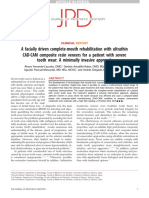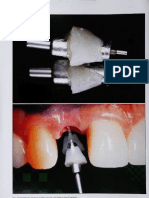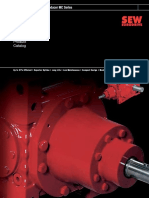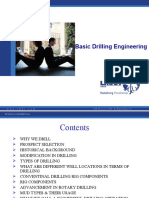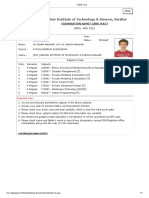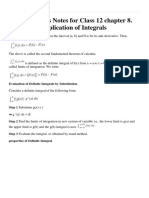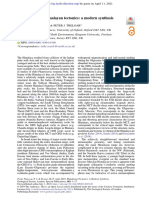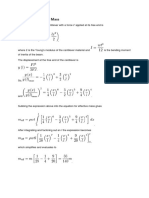Terry Part-One PDF
Terry Part-One PDF
Uploaded by
hptuanamaCopyright:
Available Formats
Terry Part-One PDF
Terry Part-One PDF
Uploaded by
hptuanamaOriginal Title
Copyright
Available Formats
Share this document
Did you find this document useful?
Is this content inappropriate?
Copyright:
Available Formats
Terry Part-One PDF
Terry Part-One PDF
Uploaded by
hptuanamaCopyright:
Available Formats
ID-AE JanFeb 2015_49-64_Layout 1 2015/02/02 10:43 AM Page 4
CLINICAL
Using injectable resin composite: part one
Douglas Terry1 and John Powers2
The injectable resin composite technique is a novel indirect/direct process of
predictably translating a diagnostic wax-up into composite restorations.
There are a myriad of applications for this technique using a highly filled flowable
resin composite. The clinical applications include emergency repair of fractured
teeth and restorations, fabricating provisional restorations (Terry, 2012), transitional
composite restorations (class III, IV, veneers) and paediatric composite crowns,
resurfacing occlusal wear on posterior composite restorations, establishing incisal edge
length prior to aesthetic crown lengthening, and developing composite prototypes for
copy milling.
In addition, this technique can be used to establish vertical dimension and for
altering occlusal schemes (anterior guidance and posterior disclusion) prior to restoring
with final restorations. Furthermore, this non- invasive technique is an integral tool for
enhancing communication between the patient and restorative team during treatment
planning.
This article presents a case report involving the use of the injectable resin composite
technique to develop transitional resin composite restorations.
Prototypes
Developing transitional resin composite restorations using the injectable technique is
an excellent method to increase the patient’s understanding of the planned clinical
procedure and anticipated final result (Terry, Leinfelder, Geller, 2009).
1
Douglas Terry, DDS.
Assistant Professor, Department
of Restorative Dentistry and
Biomaterials, University of Texas
School of Dentistry, Houston,
Texas, USA. Private Practice,
Houston, Texas, USA
2
John Powers, PhD.
Clinical Professor of Oral
Biomaterials, University of Texas Figure 1: Preoperative view of the maxillary anterior segment in a 63-year-old. Patient with
School of Dentistry, Houston, incisal wear and fracture requested a conservative aesthetic enhancement without
Texas, USA orthodontic treatment.
52 INTERNATIONAL DENTISTRY – AFRICAN EDITION VOL. 5, NO. 1
ID-AE JanFeb 2015_49-64_Layout 1 2015/02/02 10:43 AM Page 5
CLINICAL
Transitional composite prototypes allow the patient and
restorative team to establish parameters for:
• Occlusal function (Heymann, 1987) a
• Tooth position and alignment (Gürel, 2003)
• Restoration shape and physiologic contour (Baratieri,
1998)
• Restorative material colour and texture
• Lip profile
• Phonetics
• Incisal edge position
• Gingival orientation.
In addition, this process helps to eliminate confusion and
misunderstanding between the patient and the team during b
the treatment planning stage. This technique can also be
used in the development and management of soft tissue
profiles and in the design of the definitive restoration
(Donovan, Cho, 1999; Preston, 1976; Yuodelis, Faucher
1980; Saba, 1997).
The clinician and technician can use this reversible and
preparation-less technique as a guide for developing a
pre-approved functional and aesthetic final restoration. This
process aids them during the design and fabrication of the
definitive restoration, by providing a visualisation for the
c
patient and the team as well as communicating extensive
details concerning the treatment plan and the fabrication of
Figures 2a, b and c: Clinical evaluation revealed multiple
final restorations (Terry, Geller, 2013). In some cases, these diastemas and cervical corrosion on the central incisors.
transitional restorations can be worn for months or even years
by patients during long-term interdisciplinary rehabilitation
(Terry, 2012).
This technique can be performed without anaesthesia. A dissatisfaction and litigation since the process is reversible,
clear vinyl polysiloxane impression material is used to replicate can be performed without preparation and allows the
the diagnostic wax-up. The clear matrix can be placed over patient to accept the visual and functional result before the
the unprepared teeth and used as a transfer vehicle for the definitive restorations are fabricated.
flowable composite resin to be injected and cured. In addition, this simple procedure helps to regulate the
Once adjustment and polishing have been completed, the dimensions of the preparation design, ensures uniform
transitional composite restorations can be further modified spatial parameters for the restorative material, and increases
to satisfy the functional and aesthetic needs of the patient. the potential for a more conservative preparation design
This procedure can reduce the potential for patient (Terry, 2012).
VOL. 5, NO. 1 INTERNATIONAL DENTISTRY – AFRICAN EDITION 53
ID-AE JanFeb 2015_49-64_Layout 1 2015/02/02 10:43 AM Page 6
TERRY / POWERS
Figure 3a: Development of a diagnostic wax-up for the final Figure 3b: A clear vinyl polysiloxane matrix replicates the
restorations. diagnostic wax-up.
Case report cervical corrosion on the central incisors from lemon sucking
A 63-year-old male patient presented with concerns (Figures 2a and 2b). Additional occlusal findings indicated
regarding incisal wear and fracture of his maxillary anterior insufficient canine guidance and posterior disclusion. After
teeth (Figure 1). occlusal evaluation, a new occlusal scheme was developed
Clinical evaluation revealed multiple diastemas and with a diagnostic wax-up (Figure 3a). A clear vinyl
Figure 4: A hybrid resin composite placed Figure 5a: Before the adhesive surface Figure 5b: A 37.5% phosphoric acid
in the clear matrix and positioned on the preparation, each tooth is separated by semi-gel was applied to the enamel surface
maxillary right central and light-cured. applying Teflon tape on the adjacent teeth. for 30 seconds, rinsed and air-dried.
Figure 5c: A single component adhesive Figure 5d: The adhesive is air-dried for five Figure 5e: The adhesive is then light-cured
was applied to the enamel surface and seconds. for 10 seconds.
allowed to dwell for 10 seconds.
54 INTERNATIONAL DENTISTRY – AFRICAN EDITION VOL. 5, NO. 1
ID-AE JanFeb 2015_49-64_Layout 1 2015/02/02 10:43 AM Page 8
TERRY / POWERS
Figure 6a: A clear silicone matrix placed Figure 6b: Resin composite cured through
over the arch and an opacious A2-shaded the clear resin matrix.
flowable resin composite injected above
each tooth.
polysiloxane matrix was used to replicate the diagnostic Each tooth was then separated by applying Teflon or a
wax-up. The impression was taken in a non-perforated plastic small amount of glycerin to the adjacent teeth (Figure 5a).
tray (Figure 3b). This proximal adaptation technique allowed for optimal
Each tooth was pumiced and cleaned with 2% integration of flowable resin composite in the interproximal
chlorhexidine. Prior to the restorative procedure, a hybrid region while preventing adhesion of the material to adjacent
resin composite was placed in the clear matrix, positioned tooth surfaces (Terry, Leinfelder, 2004; Terry, 2004; Terry,
on the maxillary right central, and light-cured. This 2005).
technique allowed the spatial dimension of a large Depending on the duration of treatment, the method for
diastema to be controlled during the composite injection bonding requires selective spot etching or complete etching
procedure (Figure 4). of the tooth surfaces to be restored. A 37.5% phosphoric
Figure 7a: The excess polymerised Figure 7b: The incisal composite sprue Figure 7c: Using a tapered finishing
composite resin is removed. was removed with a 30-fluted tapered diamond, the tooth composite resin
finishing bur. interface was finished.
56 INTERNATIONAL DENTISTRY – AFRICAN EDITION VOL. 5, NO. 1
ID-AE JanFeb 2015_49-64_Layout 1 2015/02/02 10:43 AM Page 9
TERRY / POWERS
a b
Figure 8: The initial hybrid composite mock-up Figures 9a and 9b: The proximal surfaces and contours were smoothed with
was removed with a scalpel. tapered finishing diamond and finishing strips.
acid semi-gel was applied to the enamel surface for 30 initially injected through a small opening above each tooth,
seconds, rinsed for five seconds, and gently air-dried (Figure followed by a translucent B1 flowable resin composite
5b). A single-component adhesive was applied to the (Figure 6a). The resin composite was cured through the
enamel surface, allowed to dwell for 10 seconds (Figure clear resin matrix for 40 seconds (Figure 6b) and the
5c), air-dried for five seconds (Figure 5d), and light-cured
for 10 seconds (Figure 5e).
The clear silicone matrix was placed over the arch and
an opacious A2-shaded flowable resin composite was
Figure 10a: Adhesive surface preparation completed using Figure 10b: Flowable composite material is injected through an
total-etch technique. opening in the matrix.
Figure 11a: The incisal composite sprue was removed, and Figure 11b: The gingival tissue was retracted and the tooth
excess composite resin removed with a scalpel. composite resin interface finished using a tapered finishing
diamond.
VOL. 5, NO. 1 INTERNATIONAL DENTISTRY – AFRICAN EDITION 57
ID-AE JanFeb 2015_49-64_Layout 1 2015/02/02 10:43 AM Page 10
TERRY / POWERS
Figure 12: The lingual tooth composite resin interface was Figure 13: Proximal surfaces and contours were smoothed with
finished using a 30-fluted pyramidal-shaped finishing bur. finishing strips.
Figure 14: Incisal and proximal contouring and smoothing Figure 15: Facial surfaces polished with silicone points.
accomplished with finishing and polishing discs.
Figure 16: Gingival region polished with silicone hollow cups. Figure 17: A goat hair wheel and diamond polishing paste are
used to further refine the surface lustre of the composite resin.
excess polymerised resin composite was removed with a contours were smoothed with a tapered finishing diamond
scalpel (Figure 7a). The incisal composite sprue was and finishing strips.
removed with a 30-fluted tapered finishing bur (Figure 7b). This restorative procedure was completed for each tooth
The gingival tissue was retracted with a gingival protector, before restoration of the next tooth (Figures 9a and 9b).
and the tooth-resin composite interface was finished using After isolation of the adjacent central, the adhesive surface
a tapered finishing diamond (Figure 7c). The initial preparation was completed using total-etch technique (Figure
mock-up on the maxillary right central was removed with 10a). The same shade combination of flowable composite
a scalpel blade (Figure 8). The proximal surfaces and material was injected through a small opening in the matrix
58 INTERNATIONAL DENTISTRY – AFRICAN EDITION VOL. 5, NO. 1
ID-AE JanFeb 2015_49-64_Layout 1 2015/02/02 10:43 AM Page 12
TERRY / POWERS
An optimally finished transitional restoration should provide
a smooth surface that will prevent plaque accumulation (Terry,
2004; Stewart, Bachman, Hatton, 1991; Berastegui et
al, 1992; Yap, Sau, Lye, 1998), and resist staining
(Goldstein, 1989). It should also possess proper marginal
adaptation and integrity (Yap, Ang, Chong, 1998) with the
ideal contours and emergence profile for improved tissue
compatibility.
For this patient, the gingival tissue was retracted with a
gingival protector to prevent tissue laceration, and the tooth
resin composite interface was finished using a tapered
Figure 18: High surface gloss was achieved with a dry cotton finishing diamond (Figure 11b).
buff applied with an intermittent staccato motion. The lingual tooth resin composite interface was finished
using a 30-fluted pyramidal shaped finishing bur. This bur
has an ideal shape that conforms to the appropriate
above the tooth, allowing the material to completely cover curvature of the tooth surface and restoration (Figure 12).
the conditioned enamel surface (Figure 10b). The resin The interproximal surfaces were smoothed with
composite was cured through the clear resin matrix for 40 aluminium oxide finishing strips, which were used
seconds. After the incisal composite sprue was removed, sequentially from fine to extra-fine (Figure 13). The incisal
the excess polymerised composite resin was removed edges of the resin composite were contoured with
(Figure 11a). After each composite injection, the same finishing and polishing discs (Figure 14). Pre-polish and
restorative procedure was completed for each tooth in the high-shine silicone points were used to smooth and polish
anterior segment. the resin composite surface (Figure 15).
a b c
Figures 19a, b and c: The completed transitional resin composite restorations with optimal anatomical form. The composite injection
technique allows the establishment of harmonious proportions of the transitional restorations and the surrounding biologic framework.
a b c
Figures 20a, b and c: The transitional resin composite restorations are inspected in centric relation, protrusive and lateral excursions.
Notice the improved posterior disclusion and anterior guidance.
60 INTERNATIONAL DENTISTRY – AFRICAN EDITION VOL. 5, NO. 1
ID-AE JanFeb 2015_49-64_Layout 1 2015/02/02 10:43 AM Page 14
TERRY / POWERS
Figure 21: The composite transitional restorations establish the optimal aesthetic parameters for a natural smile.
The gingival region was smoothed and polished with final result. This process allows the functional and aesthetic
pre-polish and high-shine silicone hollow cups, which concerns to be resolved by the entire restorative team
provide additional flexibility at the cervical curvature of before final restorative treatment is initiated.
the tooth (Figure 16). The facial surface was polished The future clinical applications of this novel technique
to a high lustre with synthetic diamond paste using a may provide clinicians and technicians with alternative
goat hair wheel, and the final surface gloss was approaches to various clinical situations while allowing
accomplished with a dry cotton buff using an intermittent them to deliver improved and predictable dental treatment
staccato motion applied at conventional speed (Figures to their patients.
17 and 18). Although the long-term benefits of this technique remain
The transitional resin composite restorations were to be determined, the clinical results achieved in the past
completed and inspected in centric relation, protrusive and seven years by the authors are extremely promising.
lateral excursions (Figures 19a-c).
The composite prototype achieved using this Further information
non-invasive injectable technique established the optimal The second part of this series, will describe and illustrate
aesthetic parameters for a natural smile (Figures 20a-c another application of the injectable resin composite
and Figure 21). technique for use with the primary dentition.
The list of references that accompany this series is
Conclusion available on request.
The injectable resin composite technique is a valuable
communication tool for increasing the patient’s
understanding of the clinical procedure and anticipated Published with permission by Private Dentistry November 2014
62 INTERNATIONAL DENTISTRY – AFRICAN EDITION VOL. 5, NO. 1
You might also like
- EAO Position Paper - Material Selection For Implant-Supported RestorationsDocument10 pagesEAO Position Paper - Material Selection For Implant-Supported RestorationsValentinaNo ratings yet
- The Immediacy Concept: Treatment Planning from Analog to DigitalFrom EverandThe Immediacy Concept: Treatment Planning from Analog to DigitalNo ratings yet
- Some Myths in Dentin Bonding An Evidence Based PerspectiveDocument7 pagesSome Myths in Dentin Bonding An Evidence Based PerspectiveCristian Aguilera100% (1)
- Ejed 11 1 Fradeani p16Document20 pagesEjed 11 1 Fradeani p16floressam2000No ratings yet
- Ways of Enhancing Pulp Preservation by Stepwise Excavation-A Systematic Review PDFDocument13 pagesWays of Enhancing Pulp Preservation by Stepwise Excavation-A Systematic Review PDFFabian ArangoNo ratings yet
- Ios and ModjawDocument9 pagesIos and ModjawmustafaNo ratings yet
- European Society of Endodontology Position Statement: Management of Deep Caries and The Exposed PulpDocument12 pagesEuropean Society of Endodontology Position Statement: Management of Deep Caries and The Exposed PulpJose Alfonso Vega VargasNo ratings yet
- Currentprotocolsforresin-Bondeddentalceramics: Markus B. Blatz,, Julian Conejo,, Amirah Alammar,, Jose AyubDocument23 pagesCurrentprotocolsforresin-Bondeddentalceramics: Markus B. Blatz,, Julian Conejo,, Amirah Alammar,, Jose AyubPablo Gutiérrez Da VeneziaNo ratings yet
- The Completely Edentulous Mandible: Treatment Plans For Fixed RestorationsDocument15 pagesThe Completely Edentulous Mandible: Treatment Plans For Fixed Restorationswaf51No ratings yet
- Carvalho Et Al 2021 IJEDDocument19 pagesCarvalho Et Al 2021 IJEDclaudia100% (1)
- 18 1994 - John Preston - The Golden Proportion RevistedDocument5 pages18 1994 - John Preston - The Golden Proportion RevistedSilvia KriNo ratings yet
- A Restrospective Periodontal Assessment of 137 Teeth After Featheredge Preparation and GingittageDocument11 pagesA Restrospective Periodontal Assessment of 137 Teeth After Featheredge Preparation and GingittageBelen AntoniaNo ratings yet
- IAAD Working Instructions - Light CuringDocument3 pagesIAAD Working Instructions - Light CuringgabyNo ratings yet
- Spear's Cemented vs. Screw-Retained Implants PDFDocument35 pagesSpear's Cemented vs. Screw-Retained Implants PDFIliana AlexandraNo ratings yet
- Crazy Eddie IncDocument10 pagesCrazy Eddie IncrianNo ratings yet
- MS Excel Word Powerpoint MCQsDocument64 pagesMS Excel Word Powerpoint MCQsNASAR IQBAL50% (2)
- Cqi 11Document73 pagesCqi 11dwimukh360No ratings yet
- Minimally Invasive Periodontal Therapy: Clinical Techniques and Visualization TechnologyFrom EverandMinimally Invasive Periodontal Therapy: Clinical Techniques and Visualization TechnologyNo ratings yet
- Treatment Planning Single Maxillary Anterior Implants for DentistsFrom EverandTreatment Planning Single Maxillary Anterior Implants for DentistsNo ratings yet
- Clinical Maxillary Sinus Elevation SurgeryFrom EverandClinical Maxillary Sinus Elevation SurgeryDaniel W. K. KaoNo ratings yet
- Ferrule PDFDocument7 pagesFerrule PDFVidya SenthuNo ratings yet
- Previsualization A Useful System For Truly Informed Consent To EstheticDocument11 pagesPrevisualization A Useful System For Truly Informed Consent To EstheticEvelina HaddadienNo ratings yet
- QDT 2010Document228 pagesQDT 2010Ivan Georgiev100% (1)
- BoptloiDocument14 pagesBoptloiSonea M100% (2)
- 0 Orthotics Bhargava Et Al 2023Document11 pages0 Orthotics Bhargava Et Al 2023David MonroyNo ratings yet
- J Esthet Restor Dent - 2022 - Falacho - Clinical in Situ Evaluation of The Effect of Rubber Dam Isolation On Bond StrengthDocument8 pagesJ Esthet Restor Dent - 2022 - Falacho - Clinical in Situ Evaluation of The Effect of Rubber Dam Isolation On Bond StrengthAmaranta AyalaNo ratings yet
- Esthetic Analysis Checklist: 8 Steps For Systematic Treatment PlanningDocument1 pageEsthetic Analysis Checklist: 8 Steps For Systematic Treatment PlanningMarcus EskilssonNo ratings yet
- 20 2003 - Magne - Anatomic Crown Width LengthDocument9 pages20 2003 - Magne - Anatomic Crown Width LengthSilvia KriNo ratings yet
- J Esthet Restor Dent - 2020 - Vargas - A Systematic Approach To Contouring and Polishing Anterior Resin CompositeDocument7 pagesJ Esthet Restor Dent - 2020 - Vargas - A Systematic Approach To Contouring and Polishing Anterior Resin CompositeScarleth Stephania Perez CastilloNo ratings yet
- A New Veneer Technique With Prefabricated Composite Denture Teeth Combined With The "Biologically Oriented Preparation Technique" (BOPT) - A Case Report PDFDocument14 pagesA New Veneer Technique With Prefabricated Composite Denture Teeth Combined With The "Biologically Oriented Preparation Technique" (BOPT) - A Case Report PDFLinda Garcia PNo ratings yet
- Vandooren Interdisc 3 LeseprobeDocument41 pagesVandooren Interdisc 3 LeseprobeNdeye Bineta NdiayeNo ratings yet
- J Esthet Restor Dent - 2023 - FicheraDocument12 pagesJ Esthet Restor Dent - 2023 - FicheraFedex Du moralexNo ratings yet
- Parte 2Document21 pagesParte 2chaps1995No ratings yet
- Thickness Measuring Splint A Device For Control and Precision in Tooth Preparation, Case Planning, and Composite Resin StratificationDocument14 pagesThickness Measuring Splint A Device For Control and Precision in Tooth Preparation, Case Planning, and Composite Resin StratificationrafaelNo ratings yet
- Occlusal Considerations For Implant-Supported Prostheses - Implant-Protective OcclusionDocument39 pagesOcclusal Considerations For Implant-Supported Prostheses - Implant-Protective Occlusionandrea.lopp.paNo ratings yet
- IJEDe 16 01 ScolavinoPaolone 722 3Document24 pagesIJEDe 16 01 ScolavinoPaolone 722 3Mauri EsnaNo ratings yet
- IPS E-Max Ceram SelectionDocument22 pagesIPS E-Max Ceram SelectionCalin Nicoara100% (1)
- A Facially Driven Complete-Mouth Rehabilitation With Ultrathin CAD CAM Composite Resin Veneers For A Patient With Severe Tooth Wear A Minimally Invasive ApproachDocument11 pagesA Facially Driven Complete-Mouth Rehabilitation With Ultrathin CAD CAM Composite Resin Veneers For A Patient With Severe Tooth Wear A Minimally Invasive ApproachAlex Gutierrez AcostaNo ratings yet
- Bedrossian Treatment Planning The Maxilla PDFDocument11 pagesBedrossian Treatment Planning The Maxilla PDFSitiKhadijahNo ratings yet
- Biomechanical Considerations For The Restoration of Endodontically Treated TeethDocument13 pagesBiomechanical Considerations For The Restoration of Endodontically Treated TeethSoraya BouchammaNo ratings yet
- Ultimate Ceramic Veneers A Laboratory-Guided Ultraconservative PreparationDocument15 pagesUltimate Ceramic Veneers A Laboratory-Guided Ultraconservative PreparationEvelina HaddadienNo ratings yet
- 36.gonzalez Martin Et Al Ultrathin Feldespathic Ceramic Veneers A Pilot Sem Evaluation of Etched Intaglio Surfaces (2024)Document12 pages36.gonzalez Martin Et Al Ultrathin Feldespathic Ceramic Veneers A Pilot Sem Evaluation of Etched Intaglio Surfaces (2024)Yrene Betancourt Garrido100% (1)
- Ejed 9 3 Tirlet p354Document16 pagesEjed 9 3 Tirlet p354Ángela María GuevaraNo ratings yet
- C24024 - Harmonize Shade Guide - EN UK PDFDocument7 pagesC24024 - Harmonize Shade Guide - EN UK PDFFabio RibeiroNo ratings yet
- 2018 Global Diagnosis HandoutDocument5 pages2018 Global Diagnosis HandoutmaiNo ratings yet
- Update On The Index Technique' in Worn Dentition - A No-Prep Restorative Approach With A Digital WorkflowDocument23 pagesUpdate On The Index Technique' in Worn Dentition - A No-Prep Restorative Approach With A Digital WorkflowNaoki Mezarina100% (1)
- Telescopic Dentures: An Overlooked TechnologyDocument3 pagesTelescopic Dentures: An Overlooked TechnologyarchanglsNo ratings yet
- Crown Lengthing PDFDocument10 pagesCrown Lengthing PDFnarahari talurNo ratings yet
- 3 Te On Tape Technique Synergy Between Isolation and LucidityDocument7 pages3 Te On Tape Technique Synergy Between Isolation and LucidityfairydeobiNo ratings yet
- JERD Special Annual Issue Advances in Esthetic Dentistry 2023Document302 pagesJERD Special Annual Issue Advances in Esthetic Dentistry 2023VictorNo ratings yet
- Peumans - 2020 - Effective Protocol For Daily High-Quality Direct Posterior ComDocument59 pagesPeumans - 2020 - Effective Protocol For Daily High-Quality Direct Posterior ComJussurNo ratings yet
- Prepared Cavities On The StrenDocument4 pagesPrepared Cavities On The StrenPriyank RaiNo ratings yet
- Colour Science and Shade Selection For PDFDocument75 pagesColour Science and Shade Selection For PDFSadek MohamedNo ratings yet
- Lingualized Occlusion Dental Lab International PDFDocument3 pagesLingualized Occlusion Dental Lab International PDFArun PrasadNo ratings yet
- Immediate Implant Placement PDFDocument11 pagesImmediate Implant Placement PDFFerdinan PasaribuNo ratings yet
- 文獻2 Custom impression coping for an exact registration of the healed tissue in the esthetic implant restorationDocument8 pages文獻2 Custom impression coping for an exact registration of the healed tissue in the esthetic implant restoration歐亦焜100% (1)
- Unit 9.the Suction Mechanism of The Complete DentureDocument35 pagesUnit 9.the Suction Mechanism of The Complete DentureLama NahedNo ratings yet
- Tooth Structure Removal Associated With Various Preparation Designs For Anterior TeethDocument7 pagesTooth Structure Removal Associated With Various Preparation Designs For Anterior TeethAlina AnechiteiNo ratings yet
- Linkevisius Ti-BaseDocument6 pagesLinkevisius Ti-Basekatherina rozicNo ratings yet
- Consumer Protection Rights in BangladeshDocument34 pagesConsumer Protection Rights in Bangladeshmd.jewel ranaNo ratings yet
- SEW Compact Constant Speed Reducer MC SeriesDocument195 pagesSEW Compact Constant Speed Reducer MC SeriesDênis DáyolNo ratings yet
- Activity 2.9 Explanation: HCL H + CLDocument2 pagesActivity 2.9 Explanation: HCL H + CLsciencee2009No ratings yet
- Chapter 10 Justice and FairnessDocument22 pagesChapter 10 Justice and FairnessFallaria Paulo A.No ratings yet
- How To Make Your Own EC-135: Paintkit & Configuration Plug-InDocument8 pagesHow To Make Your Own EC-135: Paintkit & Configuration Plug-InStephen OHaraNo ratings yet
- Bài tập Anh 11 HKII (Trắc nghiệm)Document48 pagesBài tập Anh 11 HKII (Trắc nghiệm)Cường NguyễnNo ratings yet
- Kaif PDFDocument38 pagesKaif PDFjaansanju1552No ratings yet
- Basic Drilling EngineeringDocument26 pagesBasic Drilling Engineeringgfaux03No ratings yet
- Turok Evolution Prima Official EguideDocument120 pagesTurok Evolution Prima Official Eguidearturo2013No ratings yet
- 3L11804-E-3 AC Servo Pull FeederDocument82 pages3L11804-E-3 AC Servo Pull FeederBVB TecnologiaNo ratings yet
- Astm D2887Document20 pagesAstm D2887ammarNo ratings yet
- System Design and Modeling With SimulinkDocument0 pagesSystem Design and Modeling With SimulinkSharmila ChowdhuriNo ratings yet
- Madhav Institute of Technology & Science, Gwalior: Examination Admit Card (Eac)Document1 pageMadhav Institute of Technology & Science, Gwalior: Examination Admit Card (Eac)Rohan MalakarNo ratings yet
- Otc 6267 MSDocument16 pagesOtc 6267 MSnandani sudamaNo ratings yet
- GiereUnderstanding Scientific Reasoning PDFDocument15 pagesGiereUnderstanding Scientific Reasoning PDFAna Laura SotoNo ratings yet
- 5 Powerful Lessons in The Life of Cain and Abel 1Document5 pages5 Powerful Lessons in The Life of Cain and Abel 1Mercy Balagosa Palmares100% (1)
- 12 Math Notes CHP 9Document13 pages12 Math Notes CHP 9Shah KavishNo ratings yet
- Picture Clause CharacteristicsDocument11 pagesPicture Clause CharacteristicsSEEMADEVAKSATHA DNo ratings yet
- Semester-Long Internship Report: Tanmay Srinath (BMSCE, Bangalore)Document31 pagesSemester-Long Internship Report: Tanmay Srinath (BMSCE, Bangalore)hiiNo ratings yet
- ACCOUNTING TUTORIALS (Income Statement)Document1 pageACCOUNTING TUTORIALS (Income Statement)Rizza Christine Thereza UsbalNo ratings yet
- Himalayan OrogenicDocument17 pagesHimalayan Orogenictamir chongNo ratings yet
- Clinic System SRSDocument14 pagesClinic System SRSAshraf Sayed AbdouNo ratings yet
- 42pf9966 10 PssDocument3 pages42pf9966 10 PssВеселовський ПетроNo ratings yet
- Read The Text and Answer The Questions English Academic Writing: The "A" PaperDocument2 pagesRead The Text and Answer The Questions English Academic Writing: The "A" PaperКсенияNo ratings yet
- Cantilever Effective Mass of CANTILEVERDocument1 pageCantilever Effective Mass of CANTILEVERshangz1511No ratings yet
- Notes On ODDocument18 pagesNotes On ODMona GavaliNo ratings yet









































